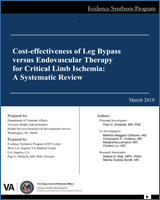This publication is in the public domain and is therefore without copyright. All text from this work may be reprinted freely. Use of these materials should be acknowledged.
NCBI Bookshelf. A service of the National Library of Medicine, National Institutes of Health.
Critical limb ischemia (CLI) is a severe form of peripheral arterial disease (PAD) marked by ischemic rest pain, tissue loss, or gangrene. CLI is associated with significant morbidity, mortality, and resource utilization. Patients can be treated with revascularization, either surgical or endovascular. To help clinicians, patients, and policymakers decide between surgery-first and endovascular-first approaches in patients with CLI, we were asked to conduct a systematic review of the literature.
Contents
- Preface
- Acknowledgments
- Abstract
- Introduction
- Methods
- Results
- Summary and Discussion
- References
- APPENDIX A. Search Strategy
- APPENDIX B. Peer Reviewer Comments and Responses
- APPENDIX C. Cochrane Risk of Bias Tool
- APPENDIX D. Risk of Bias in Non-Randomised Studies – of Interventions (ROBINS-I)
- APPENDIX E. Quality Assessment for Included RCT Study
- APPENDIX F. Quality Assessment for Included Observational Studies
- APPENDIX G. Evidence Table
- APPENDIX H. Citations for Excluded Publications
Suggested citation:
Childers C, Lamaina M, Liu C, Mak S, Booth M, Gibbons M, Shekelle PG. Cost-effectiveness of Leg Bypass versus Endovascular Therapy for Critical Limb Ischemia. Washington, DC: Evidence Synthesis Program, Health Services Research and Development Service, Office of Research and Development, Department of Veterans Affairs.VA ESP Project#05-226; 2019. Available at: https://www.hsrd.research.va.gov/publications/esp/reports.cfm.
This report is based on research conducted by the Evidence Synthesis Program (ESP) Center located at the West Los Angeles VA Medical Center, Los Angeles, CA, funded by the Department of Veterans Affairs, Veterans Health Administration, Health Services Research and Development. The findings and conclusions in this document are those of the author(s) who are responsible for its contents; the findings and conclusions do not necessarily represent the views of the Department of Veterans Affairs or the United States government. Therefore, no statement in this article should be construed as an official position of the Department of Veterans Affairs. No investigators have any affiliations or financial involvement (eg, employment, consultancies, honoraria, stock ownership or options, expert testimony, grants or patents received or pending, or royalties) that conflict with material presented in the report.
- NLM CatalogRelated NLM Catalog Entries
- Review Interventional management of critical limb ischemia in renal patients.[Adv Chronic Kidney Dis. 2008]Review Interventional management of critical limb ischemia in renal patients.Casserly IP. Adv Chronic Kidney Dis. 2008 Oct; 15(4):384-95.
- Review Treatment Strategies for Patients With Peripheral Artery Disease[ 2013]Review Treatment Strategies for Patients With Peripheral Artery DiseaseJones WS, Schmit KM, Vemulapalli S, Subherwal S, Patel MR, Hasselblad V, Heidenfelder BL, Chobot MM, Posey R, Wing L, et al. 2013 May
- Nationwide Trends of Hospital Admission and Outcomes Among Critical Limb Ischemia Patients: From 2003-2011.[J Am Coll Cardiol. 2016]Nationwide Trends of Hospital Admission and Outcomes Among Critical Limb Ischemia Patients: From 2003-2011.Agarwal S, Sud K, Shishehbor MH. J Am Coll Cardiol. 2016 Apr 26; 67(16):1901-13. Epub 2016 Mar 21.
- Rationale and design of the MarrowStim PAD Kit for the Treatment of Critical Limb Ischemia in Subjects with Severe Peripheral Arterial Disease (MOBILE) trial investigating autologous bone marrow cell therapy for critical limb ischemia.[J Vasc Surg. 2017]Rationale and design of the MarrowStim PAD Kit for the Treatment of Critical Limb Ischemia in Subjects with Severe Peripheral Arterial Disease (MOBILE) trial investigating autologous bone marrow cell therapy for critical limb ischemia.Wang SK, Green LA, Motaganahalli RL, Wilson MG, Fajardo A, Murphy MP. J Vasc Surg. 2017 Jun; 65(6):1850-1857.e2. Epub 2017 Apr 5.
- Review [Indications and results of endovascular therapy of critical limb ischemia].[Radiologe. 2016]Review [Indications and results of endovascular therapy of critical limb ischemia].Zimmermann A, Ludwig U, Eckstein HH. Radiologe. 2016 Mar; 56(3):216-22.
- Cost-effectiveness of Leg Bypass versus Endovascular Therapy for Critical Limb I...Cost-effectiveness of Leg Bypass versus Endovascular Therapy for Critical Limb Ischemia: A Systematic Review
- PREDICTED: Homo sapiens ATPase plasma membrane Ca2+ transporting 1 (ATP2B1), tra...PREDICTED: Homo sapiens ATPase plasma membrane Ca2+ transporting 1 (ATP2B1), transcript variant X7, mRNAgi|2217289225|ref|XM_047428896.1|Nucleotide
- Homo sapiens ATPase plasma membrane Ca2+ transporting 1 (ATP2B1), transcript var...Homo sapiens ATPase plasma membrane Ca2+ transporting 1 (ATP2B1), transcript variant 26, mRNAgi|2320875689|ref|NM_001413056.1|Nucleotide
- Homo sapiens phospholipase C, gamma 2 (phosphatidylinositol-specific), mRNA (cDN...Homo sapiens phospholipase C, gamma 2 (phosphatidylinositol-specific), mRNA (cDNA clone MGC:19776 IMAGE:3678272), complete cdsgi|33874412|gb|BC011772.2|Nucleotide
Your browsing activity is empty.
Activity recording is turned off.
See more...
